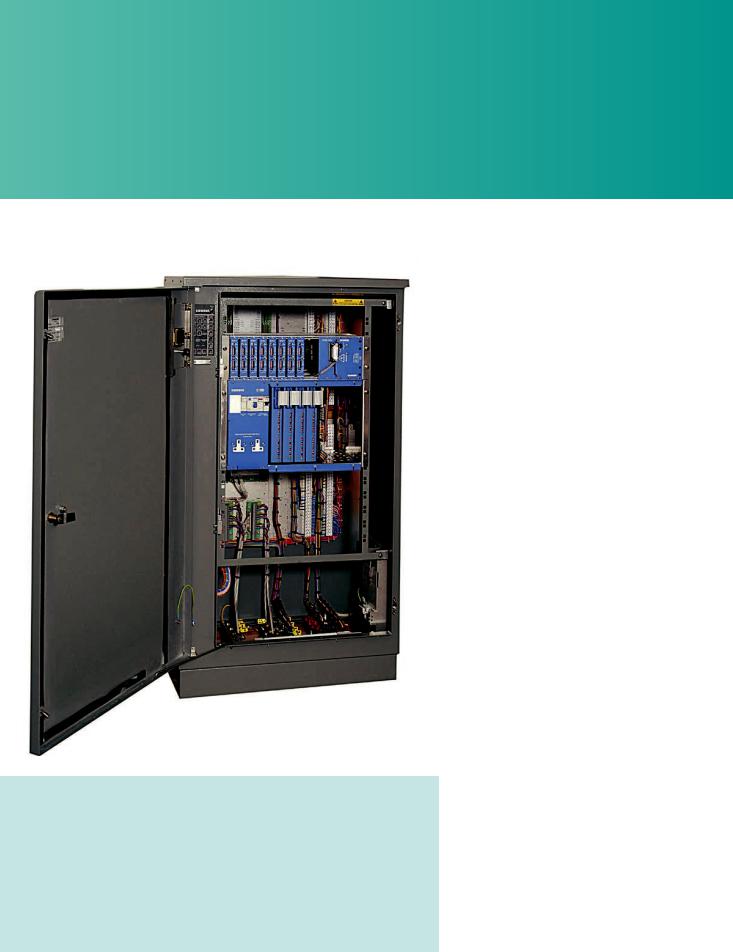Siemens ST950 User guide

ST950
Intersection controller
siemens.co.uk/traffic

ITS Detection Solutions
ST950 Intersection controller
The ST950 is the latest in a long line of highly successful intersection controllers from Siemens. Building on more than 30 years of microprocessor based traffic controller design, the ST950 family offers both familiarity and many exciting new user and maintenance features.
With integrated UTMC based UTC SCOOT, Stratos Remote Monitoring and MOVA functionality it offers great flexibility, providing Intersection, Pelican, Puffin and Toucan methods of control, at both LV (230V) and ELV (40V, 42V and 48V) output drive level options.
The controller family is compatible with the whole range of Siemens street-furniture, including Helios CLS LED traffic signals, LED nearside signals and LED wait indicators, which all offer significant power and cost savings compared with conventional incandescent solutions.
Fully integrated UTMC and MOVA 7 functionality
Using a powerful ARM microprocessor core, the ST950 is able to offer fully integrated UTMC and MOVA functionality utilising advanced IP communications to the central office, without the need for additional outstation equipment. Up to 4 MOVA streams and up to 64 detectors per MOVA stream are supported.
Each stream is configured using the familiar MOVA set-up program and communication with MOVA is achieved via an IP link using MOVACOM. MOVA is also available via the controllers web browser interface which offers a MOVACOM like function, allowing MOVA to be accessed remotely and via non PC devices such as tablets or mobile phones.
MOVA data-sets are able to be changed either locally or remotely without impacting the running controller onstreet. A MOVA mode is also provided by the controller, explicitly enabling MOVA control to be reported back to an associated instation system.
Full UTMC OTU functionality is also supported using the same principles and offering a similar user experience to that provided by the Stratos Outstation, minimising user retraining.
Full Stratos Remote Monitoring functionality is provided allowing detailed site fault reporting, via the Stratos system. Remote Monitoring, UTC SCOOT and MOVA functionality are all able to be used together, as dictated by traffic engineering needs.
2

ITS Detection Solutions
The controller may be specified to include an additional 2U equipment rack, which neatly houses the chosen IP communication router or modem, providing for example, ADSL, Fiber or 3G communications to the central system.
Easy to use user interfaces
To simplify user interaction with the controller, the ST950 provides an extensive web browser interface which is accessible either locally or remotely. Offering a consistent style and where appropriate consistent functionality with the free standing GEMINI UTMC OTU, this interface is able to be accessed locally via a USB port on the controller CPU, via Ethernet (if a communications router is provided) or via a simple plug-in Wi-Fi interface module.
If necessary the ST950 may be configured to require PKI certificate access. If enabled, only users who are in possession of the valid certificate are able to make changes to the controller data and all such changes are recorded, along with the name of the person making the changes.
Related data items are conveniently grouped together so that data changes can be made with the minimum of page-changing. The interface fully manages the control of level 3 data items and will actively prevent these from being changed remotely (as required by TR2500), whilst ensuring that other changes are able to be made simply and efficiently.
The browser interface is capable of supporting multiple languages and new languages are able to be easily added to the system as required.
The interface also supports a live site map which shows the status of key items, such as phases and detectors in real time on a graphical representation of the site.
Signal heads may be shown as aspect displays or as STS representative symbols allowing users to easily appreciate the whole site operation in real time. Data for the map display may be configured locally or imported from the IC4 Emulator tool.
A standard TR2500 25-way serial handset port is also provided and many controller features are able to be altered using the traditional Siemens handset mnemonics if required.
•Fully integrated UTMC OTU and MOVA 7 functionality
•Fully integrated Stratos Remote Monitoring
•Easy to use web based user interface
•Inbuilt live graphical site map
•Unique audible feedback of controller operation to ease on-street maintenance activities
•Multi-Language capability
•Local and remote user access with optional PKI security and user action logging
•LV (230V) and ELV (40V, 42V and 48V) lamp drive systems
•Up to 32 phases, 32 stages and 8 independent streams.
•Up to 240 digital inputs/output lines
•Integral lamp monitoring of all phases and signal colours
3

ITS Detection Solutions
Integrated LV (230V) and ELV (40V, 42V and 48V) lamp switching
•Modular construction -available in an outercase or as a 19 inch, 6U rack
•Simple installation - easily retro-fitted to existing controller cabinets
•Dual processor safety system
•Separate ‘applications’ processor
•Multi-mode operation including advanced ‘ripple’ stage change algorithm
•Supports configuration changes with signals on
•Fully approved to UK Highways Agency specification TR2500 and TR2513
The ST950 retains the robust and proven lamp switch designs of the ST900 family.
When configured as a standard 230V controller the ST950 supports both High Intensity incandescent lamps and also LED signals. Where LED signals are used, specially adapted lamp switch cards provide reliable switching and lamp monitoring, particularly for Siemens Helios LV CLS LED signals.
The ST950 ELV implements the proven Siemens full wave rectified ‘DC’ system which offers a wide range of benefits, including:
•Increased electrical safety for members of the public in the event of damage to the signal installation
•Increased electrical safety for personnel working on or around the intersection
•Reduced power costs
•Reduced cabling costs
•Reliable lamp monitoring of very low power LED traffic and pedestrian signals
•Low supply current in-rush versions minimising supply fusing and supply capacity requirements
To deliver these benefits, the ST950 ELV incorporates many unique design features including:
Use of a fully rectified ELV supply:
The use of a full wave rectified ELV supply allows very efficient semiconductor switches to be used, reducing unnecessary heating effects in the controller, contributing to improved reliability and lower power consumption.
4

ITS Detection Solutions
Active short circuit protection on all outputs: Often the most frequently damaged components within a traffic controller are the output drive switches, which are particularly vulnerable to cable faults and short circuits. The ST950 ELV design incorporates an active short circuit protection system on all lamp outputs, ensuring that even under direct short circuit conditions, the outputs are protected from damage.
Active residual current quench on all outputs: The power requirements of LED-based street furniture are becoming ever lower. As this occurs, there is an increased risk that stray and residual voltages, remaining present after a signal is switched off, will cause the controller to register conflict or correspondence faults incorrectly. The ST950 ELV is ready today to deal with the very low power signals expected in the future, as each output is equipped with an active circuit that eliminates these stray voltages, without wasting power when the signals are switched on.
Intelligent lamp switch system: The ST950 ELV provides an intelligent lamp switch card that implements full voltage monitoring on each of its 32 outputs, using two separate safety systems. Current and voltage monitoring on each output is also provided, so that any output may be used for any signal colour. Additionally, ELV LED traffic signals as well as LED nearside and LED wait indicators can be monitored directly, without the need for any additional intelligence in the signals themselves. This high degree of flexibility allows output use to be optimised, for example, only using a single drive for green arrows, making the most efficient use of the available controller hardware.
By default ST950 ELV controllers provide a nominal 48V lamp drive level, reducing to 27.5V when the signals are dimmed. Optionally the controller can provide either 40V or 42V drive levels, by the provision of an alternative ELV output transformer.
The ST950 retains the robust and proven lamp switch designs of the ST900 family.
5
